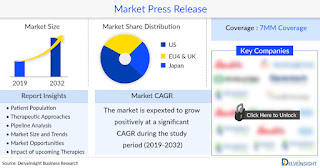Navigating the Landscape of Rare Disease Markets: A Comprehensive Overview
In the realm of healthcare, the battle against rare diseases often remains a challenging frontier. Conditions like Short Bowel Syndrome, Complement 3 Glomerulopathy, Retinitis Pigmentosa, Aplastic Anemia, Nephrotic Syndrome, Pulmonary Arterial Hypertension, Hemophilia A, and Complicated Urinary Tract Infections are not only medically complex but also pose significant burdens on patients and healthcare systems worldwide. As research progresses and innovative therapies emerge, understanding the dynamics of these niche markets becomes increasingly crucial. Let's delve into the unique characteristics, challenges, and advancements within each of these markets.
Short Bowel Syndrome (SBS) is a rare gastrointestinal
disorder characterized by the malabsorption of nutrients due to a significant
portion of the small intestine being missing or non-functional. This condition
often results from surgical resection due to conditions like Crohn's disease or
intestinal ischemia. While SBS presents significant challenges in maintaining
adequate nutrition and hydration, recent advancements in parenteral nutrition,
intestinal rehabilitation programs, and novel therapies such as teduglutide
offer hope for improved management.
Complement 3 Glomerulopathy (C3G) represents a group of rare
kidney disorders characterized by abnormal activity of the complement system,
leading to glomerular dysfunction and renal damage. Despite being relatively
uncommon, C3G poses substantial risks of progressive renal impairment and
end-stage renal disease. Treatment approaches often involve immunosuppressive
therapies, complement inhibitors, and emerging targeted therapies aimed at
modulating the dysregulated complement cascade.
Retinitis Pigmentosa (RP) comprises a heterogeneous group of
inherited retinal disorders characterized by progressive degeneration of
photoreceptor cells, leading to gradual vision loss and potential blindness.
While no definitive cure exists, ongoing research into gene therapy, retinal
prostheses, and neuroprotective agents holds promise for preserving vision and
improving quality of life for affected individuals.
Aplastic Anemia (AA) is a rare bone marrow failure disorder
characterized by hypocellular bone marrow and peripheral blood cytopenias,
predisposing patients to anemia, bleeding, and infections. The treatment
landscape includes immunosuppressive therapies, hematopoietic stem cell
transplantation, and novel approaches such as eltrombopag, a thrombopoietin
receptor agonist, offering alternatives for patients ineligible for transplant.
Nephrotic Syndrome (NS) encompasses a group of kidney
disorders characterized by the excessive urinary excretion of protein, leading
to edema, hypoalbuminemia, and hyperlipidemia. While corticosteroids remain a
cornerstone of therapy for many forms of NS, refractory cases may require
immunosuppressive agents, renin-angiotensin system inhibitors, and emerging
targeted therapies directed at specific underlying pathogenic mechanisms.
Pulmonary Arterial Hypertension (PAH) is a progressive
disorder characterized by elevated blood pressure in the pulmonary arteries,
leading to right heart failure and premature death. Despite significant
therapeutic advancements with endothelin receptor antagonists,
phosphodiesterase inhibitors, and prostacyclin analogs, PAH remains a
challenging condition with high morbidity and mortality rates, emphasizing the
need for further research into novel treatment modalities.
Hemophilia A is an X-linked genetic disorder characterized
by deficient or defective factor VIII clotting protein, resulting in prolonged
bleeding and impaired coagulation. While standard treatment involves factor
replacement therapy, recent breakthroughs in gene therapy offer the potential
for a more durable and transformative approach to managing this lifelong
condition, providing hope for reduced treatment burden and improved quality of
life.
Complicated Urinary Tract Infections (cUTIs) represent a
spectrum of infections involving the urinary tract, often complicated by
factors such as structural abnormalities, catheterization, or antibiotic
resistance. The emergence of multidrug-resistant pathogens poses significant
challenges in managing cUTIs, driving the need for innovative antimicrobial
agents, combination therapies, and alternative treatment strategies to combat
infection and prevent recurrence.
In conclusion, the landscape of rare disease markets is
evolving rapidly, driven by advances in scientific research, technology, and
therapeutic innovation. While these conditions present unique challenges, they
also offer opportunities for collaboration, investment, and advocacy to improve
outcomes and quality of life for patients affected by these often overlooked
diseases. By fostering interdisciplinary approaches, prioritizing
patient-centered care, and promoting equitable access to emerging therapies, we
can strive towards a future where no disease, no matter how rare, is left
untreated or ignored.




Comments
Post a Comment